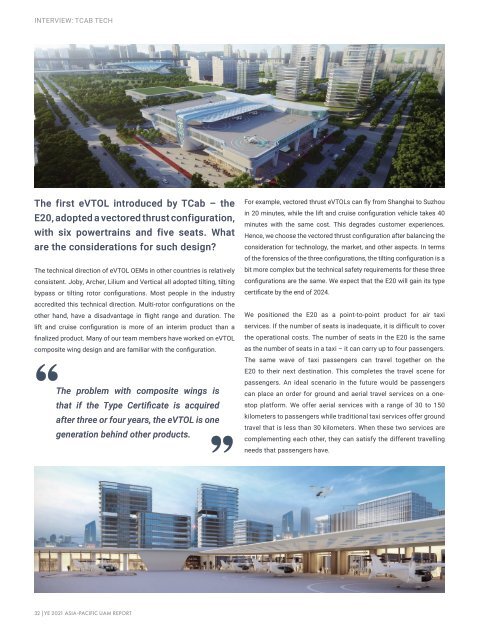APAC UAM Report YE2021
Gain a deeper understanding of the progress that is being made across the Asia Pacific with electric vertical take-off and landing (eVTOL) vehicles.
Gain a deeper understanding of the progress that is being made across the Asia Pacific with electric vertical take-off and landing (eVTOL) vehicles.
Create successful ePaper yourself
Turn your PDF publications into a flip-book with our unique Google optimized e-Paper software.
INTERVIEW: TCAB TECH<br />
The first eVTOL introduced by TCab – the<br />
E20, adopted a vectored thrust configuration,<br />
with six powertrains and five seats. What<br />
are the considerations for such design?<br />
The technical direction of eVTOL OEMs in other countries is relatively<br />
consistent. Joby, Archer, Lilium and Vertical all adopted tilting, tilting<br />
bypass or tilting rotor configurations. Most people in the industry<br />
accredited this technical direction. Multi-rotor configurations on the<br />
other hand, have a disadvantage in flight range and duration. The<br />
lift and cruise configuration is more of an interim product than a<br />
finalized product. Many of our team members have worked on eVTOL<br />
composite wing design and are familiar with the configuration.<br />
The problem with composite wings is<br />
that if the Type Certificate is acquired<br />
after three or four years, the eVTOL is one<br />
generation behind other products.<br />
For example, vectored thrust eVTOLs can fly from Shanghai to Suzhou<br />
in 20 minutes, while the lift and cruise configuration vehicle takes 40<br />
minutes with the same cost. This degrades customer experiences.<br />
Hence, we choose the vectored thrust configuration after balancing the<br />
consideration for technology, the market, and other aspects. In terms<br />
of the forensics of the three configurations, the tilting configuration is a<br />
bit more complex but the technical safety requirements for these three<br />
configurations are the same. We expect that the E20 will gain its type<br />
certificate by the end of 2024.<br />
We positioned the E20 as a point-to-point product for air taxi<br />
services. If the number of seats is inadequate, it is difficult to cover<br />
the operational costs. The number of seats in the E20 is the same<br />
as the number of seats in a taxi – it can carry up to four passengers.<br />
The same wave of taxi passengers can travel together on the<br />
E20 to their next destination. This completes the travel scene for<br />
passengers. An ideal scenario in the future would be passengers<br />
can place an order for ground and aerial travel services on a onestop<br />
platform. We offer aerial services with a range of 30 to 150<br />
kilometers to passengers while traditional taxi services offer ground<br />
travel that is less than 30 kilometers. When these two services are<br />
complementing each other, they can satisfy the different travelling<br />
needs that passengers have.<br />
32 |YE 2021 ASIA-PACIFIC <strong>UAM</strong> REPORT

















